Are you thinking about studying abroad, but are not sure if it’s worth your time? Or are you ready to participate in a study abroad program, but need some extra talking points to convince your parents that you’ve made a smart decision?
The number of American students who go abroad has more than tripled in the past two decades (304,467 students in the 2013-2014 academic year), and this increase is likely to continue. International education is on the rise, and for good reason: research has shown that students who study abroad have better career prospects and are more socially aware. Read on to discover more study abroad statistics, facts, and figures that reflect the latest trends in international education.
✈ Benefits of studying abroad
For many years, the benefits of studying abroad have been described in words like these: “It will completely change your life!” and “You will come back a new person.” But the exact long-term benefits were unknown. Now, though, the positive impact of study abroad experiences can be proven with study abroad statistics.
The Institute for International Education of Students (IES) conducted a survey to explore the long-term impact of study abroad on the personal, professional, and academic lives of students. Here are some interesting findings:
- 95% of the students who were surveyed admitted that studying abroad served as a catalyst for increased maturity, 96% reported increased self-confidence, and 95% said it had a lasting impact on their worldview.
- More than 50% of the respondents are still in contact with U.S. friends they met when studying abroad. and often see them during summer traveling.
One of the goals of study abroad programs is to train future global leaders who will respect other cultures and political and economic systems and care about the world’s welfare. The survey reveals that study abroad is succeeding in this mission:
- 98% of the students stated that study abroad helped them better understand their own cultural values and biases, and 82% said that it helped them develop a more sophisticated way of looking at the world.
- 94% stated that their study abroad experience continues to influence interactions with people from different cultures.
- 87% of the students said that study abroad influenced their subsequent educational experiences. Nearly half of all respondents took part in international work or internship (usually in an office) and/or volunteerism since studying abroad.
- Three-quarters of the respondents said that they acquired skill sets that influenced their future career paths. Companies are willing to hire students with a recommendation letter from foreign universities
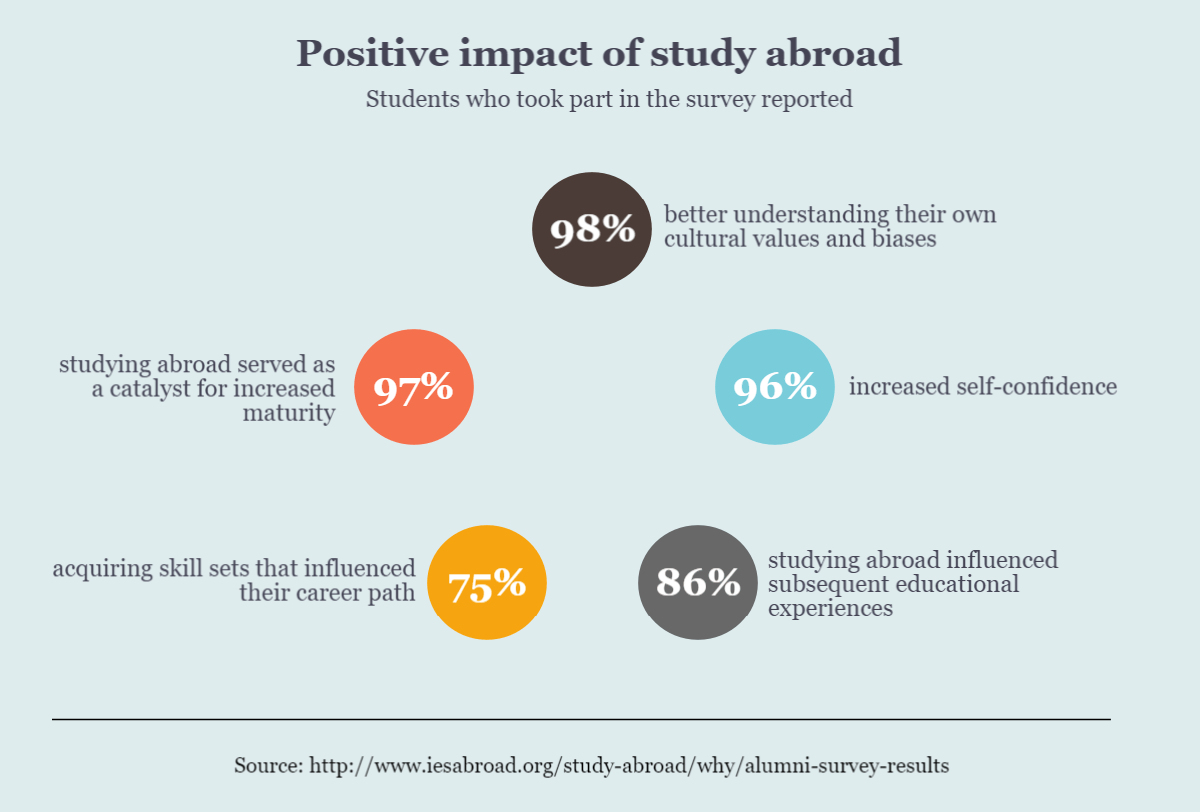
The survey results proved that studying abroad can greatly influence a student’s life. The results of the survey show that study abroad had a positive influence on the personal development, academic commitment, and career paths of the students who took part in IES study abroad programs.
Perhaps unsurprisingly, the results show that the longer students study abroad, the more significant the academic, cultural, and personal development benefits are. But the survey also suggests that study abroad programs lasting at least six weeks can also produce good academic, personal, career, and intercultural development outcomes.
The Erasmus Impact Study (2013) analyzed the effects of mobility on the skills and employability of students and on the internationalization of higher education institutions. The results of the study proved the benefits of studying abroad for the career development of mobile students. The study highlighted that mobile students are more likely to get managerial positions in their future careers and are less likely to experience long-term unemployment.
Here are some key findings.
- More than 85% of Erasmus students study abroad to enhance their employability abroad.
- More than 90% of mobile students reported that they improved their soft skills, including their knowledge of other countries, the ability to interact and work with people from different cultures, adaptability, foreign language proficiency, and communication skills.
- The statistics show that studying abroad increases the chances of successful employment. After graduation, 74% of college students reported starting a professional career.
- 80% of Chinese students return home after they master their profession to start a career in their native country.
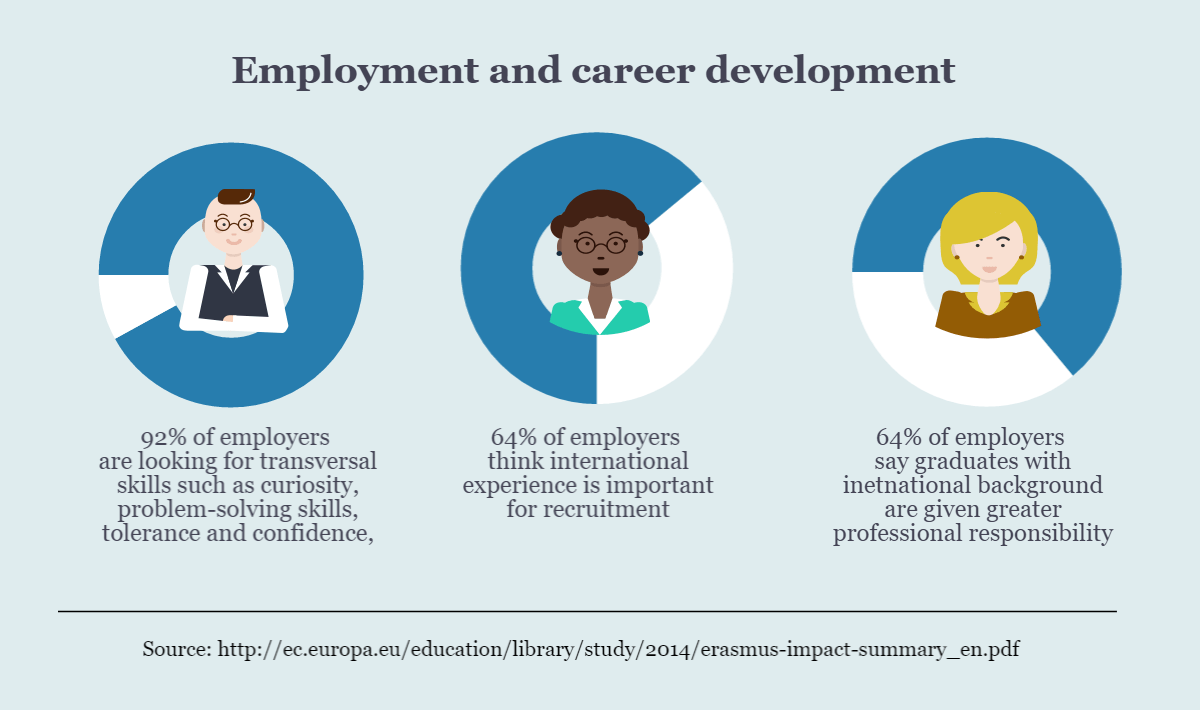
- 64% of employers think that an international experience is important for recruitment.
- Young people who study abroad are half as likely to face long-term unemployment as those who do not study abroad. The unemployment rate of Erasmus students five years after graduation is 23% lower.
- More than 1 in 3 Erasmus students who completed a job placement abroad were hired or offered a position by their host company.
- Almost 1 in 10 former mobile students who completed a job placement abroad has started a company.
- 64% of surveyed employers said that graduates with an international background are more often given greater professional responsibility.
🌐 Global trends in international student mobility
The world is becoming increasingly globalized, and international experience is one of the most essential components of higher education in the 21st century. Just take a look at these facts:
- The global number of students who study abroad continues to rise with an annual increase of 10%. There were almost 5 million international students in 2014. The Organization for Economic Co-operation and Development (OECD) has projected that, with demographic changes, the international student population is likely to reach 8 million by 2025.
- The United States, the United Kingdom, Germany, France, and Australia are the most popular host countries for international students. Half of all international students study in these five countries.
- Regions that hosted the largest number of mobile students in 2013 were North America and Western Europe (57% of total mobile students), East Asia and the Pacific (19%), and Eastern Europe (10%).
- The countries with the most students studying abroad are China and India. According to UNESCO, there were 712,157 Chinese students studying abroad in 2013. Several small countries including Andorra, Anguilla, Bermuda, Liechtenstein, Luxembourg, Montserrat, the Seychelles, and the Turks and Caicos Islands have more students studying abroad than at home.
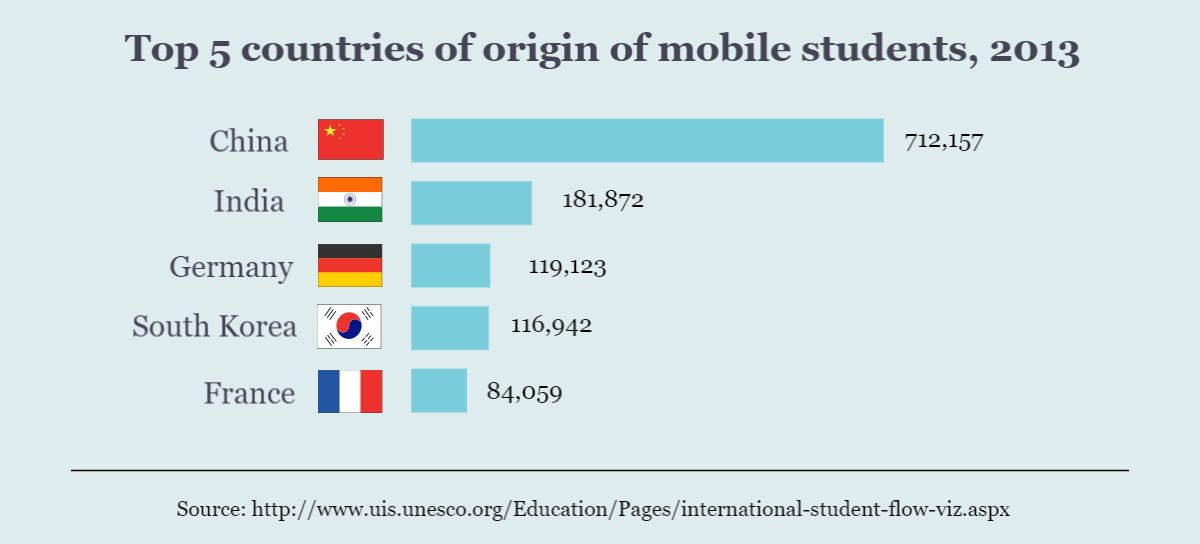
- International students who study social sciences, business and law primarily go to English-speaking countries to study (more than 30% of the total number). Australia, the United Kingdom and the United States together host 36% of all foreign students worldwide.
- New players have emerged on the international education market in the past few years, such as Canada (5% of foreign students), Japan (4%), Russia (4%), and Spain (2%). At the same time, the market share of the most popular countries is declining: the share of international students in the United States decreased from 23% to 17 % between 2000 and 2011.
- Several traditional source countries are working hard to increase their attractiveness to international students. China hosted nearly 380,000 foreign students in 2014 but has a target to attract 500,000 students by 2020; Japan is aiming for a target of 300,000 international students in 2020; and Malaysia wants to attract 250,000 foreign students by 2025.
🗽 International students in the USA
A lot of foreign students choose the United States as their study abroad destination. Here are some specific figures about international students in the USA:
- There were nearly 1.2 million international students with F (academic) or M (vocational) status in the United States, according to the latest quarterly report on international student trends released by the Student and Exchange Visitor Program (SEVP). According to data from a March 2016 SEVIS report, the number of international students at U.S. schools increased 6.2% compared to March 2015.
- 40% of international students in the USA study science, technology, engineering, or mathematics (STEM).
- New York University (13,851), the University of Southern California (13,080), Northeastern University (11,381), Columbia University (10,810) and the University of Illinois (10,690) have the highest number of international students. More than 10,000 foreign students were enrolled at each school in March 2016.
- 77% of all international students in the USA are from Asia.
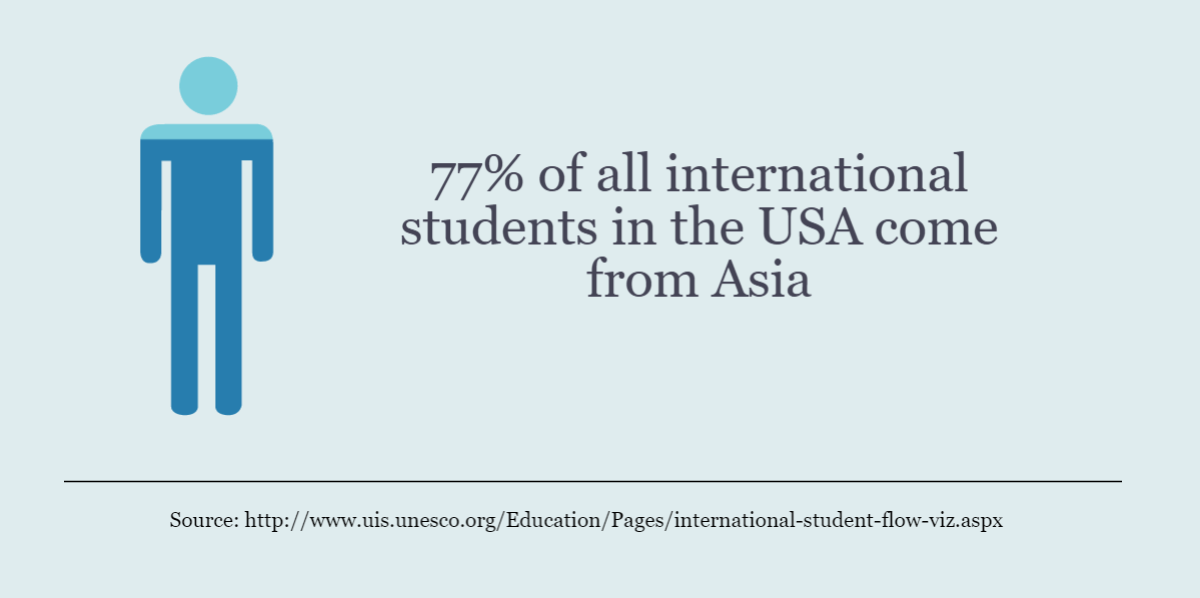
- The top 10 countries where international students come from include China, India, South Korea, Saudi Arabia, Canada, Vietnam, Japan, Taiwan, Brazil, and Mexico.
- Many countries support the idea of studying abroad. For example, Japanese university Sojo aims to make 50% of their students participate in study abroad programs.
- NAFSA’s latest analysis finds that the 974,926 international students studying at U.S. colleges and universities contributed $30 billion to the U.S. economy and supported more than 373,000 jobs during the 2014-2015 academic year.
- In their study increasing international study abroad rates for business students, Gordon and others emphasized six major barriers—money, relatives, friends, career relevance, knowledge availability, and university participation.
- Many international students aren’t informed on health insurance in the country they’re visiting. Only 14% of students confirmed the collaboration between their college/university and health organizations.
- Among 155 international students studying abroad, 90% weren’t married and didn’t have children.
🎓 U.S. students studying abroad
The problem is…
American college students are not as globally minded as theirs peer from other countries.
But the situation is improving, and the number of U.S. students going abroad keeps increasing every year, a growth pattern that is likely to continue. If you’re willing to find out more, what a better way to learn about the topic than from the students themselves in a form of free college essays examples?
- The number of U.S. students studying abroad for credit in the 2013-2014 academic year grew 5.2% from 289,408 students to 304,467 students.
- The most popular destinations for U.S. students studying abroad in the 2014-2015 academic year were the United Kingdom (38,250 U.S. students), Italy (31,166), Spain (26,949), France (17,597), China (13,763), Germany (10,377), Ireland (8,823), Australia (8,369), Japan (5,978), and South Africa (4,968).
- 63% of U.S. college freshmen aim to study abroad. However, only 14.3% graduate from foreign colleges.
- 40% of U.S. students attend studies in only five countries in Europe (UK, Germany, Italy, Spain, France) where they study to become qualified specialists, whether they return to the U.S. or stay in Europe.
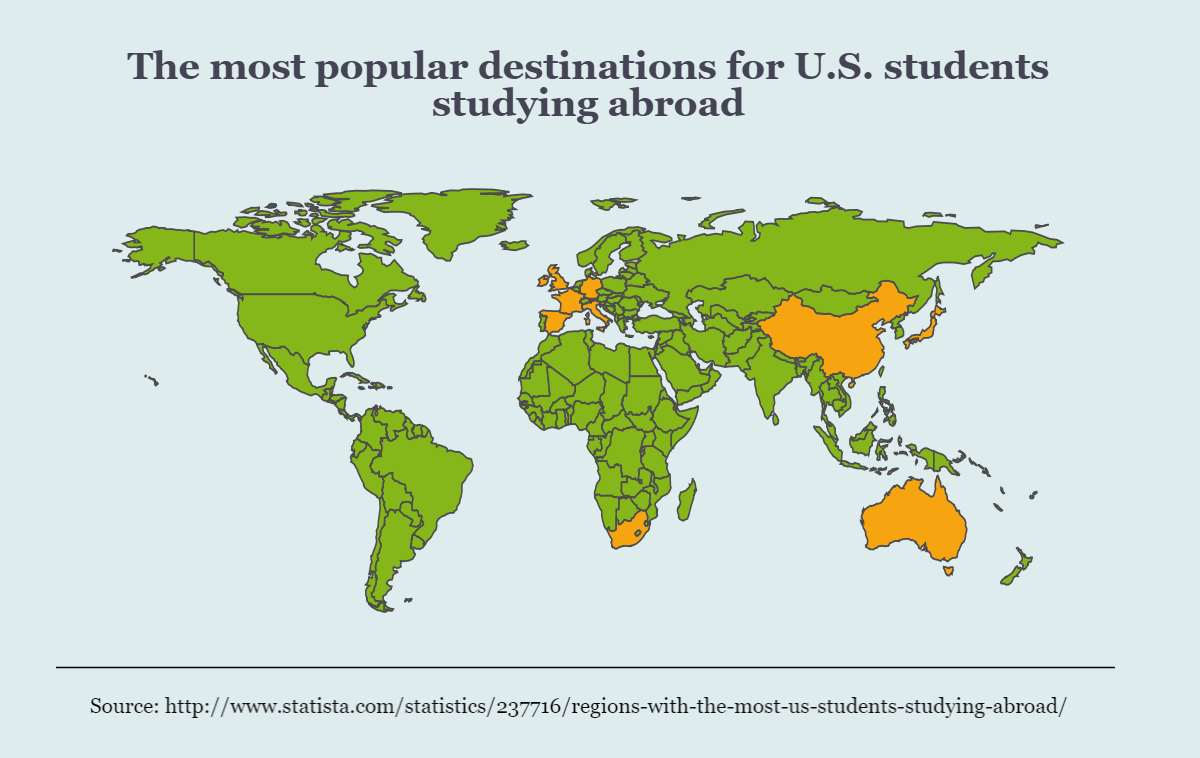
- Europe is the most popular region for U.S. students studying abroad. There were 162,282 American students studying in Europe in the 2014-2015 academic year. Latin America and the Caribbean hosted 49,312 students from the United States, while Asia hosted 36,290.
Study abroad ranking site Abroad101 notes the following up and coming countries Ghana, Cuba, Tanzania, Turkey, Morocco, Switzerland, Russia, Romania, Jordan, and the UAE. - 68,798 American students were studying science, technology, engineering, or mathematics (STEM) in different countries around the world in the 2013-2014 academic year. Another 59,687 American students were studying business, while 57,067 studied foreign languages and international studies.
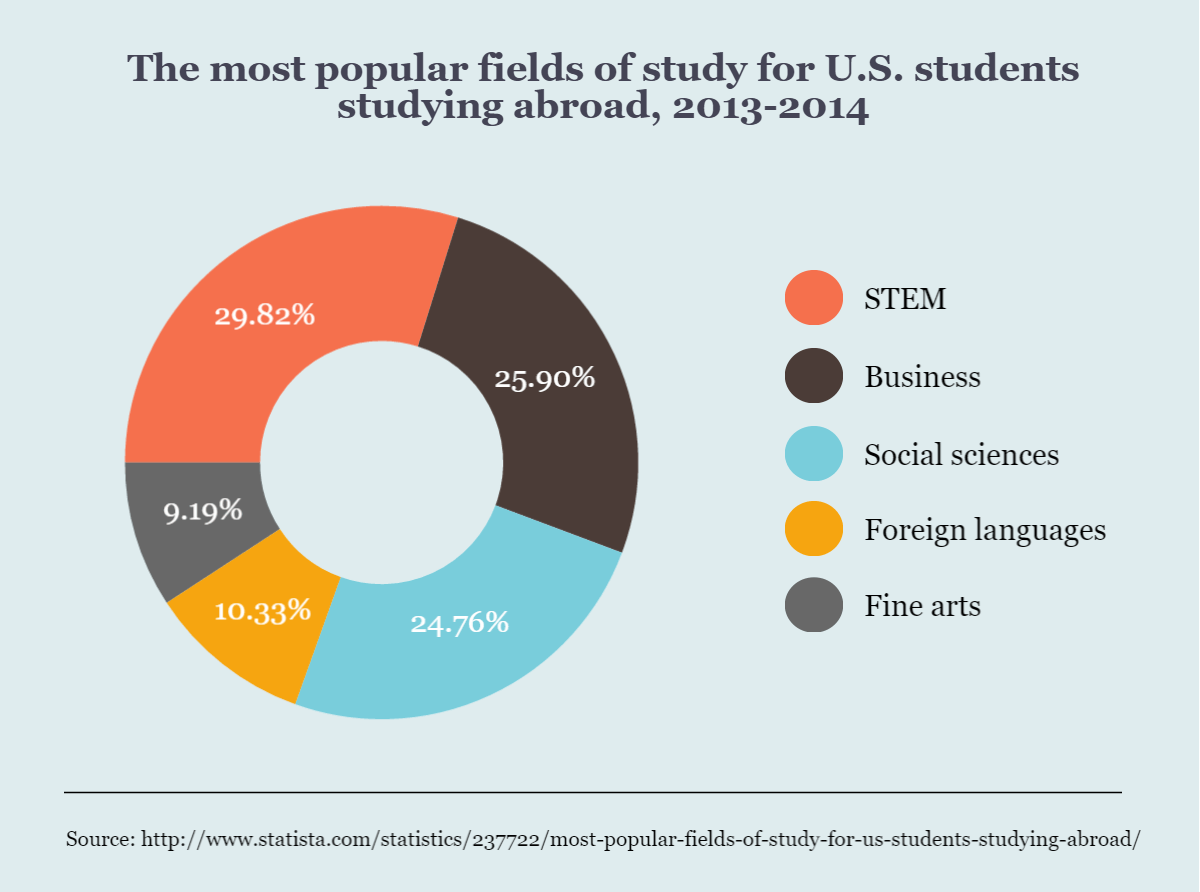
- The majority of U.S. students (62%) studied abroad for just 8 weeks or less. 35% of the students stayed for one semester, and only 3% of American students stayed long term for a year.
- 3,638 disabled students studied abroad in the 2013-2014 academic year, according to the U.S. Department of State-sponsored Open Door Report on International Educational Exchange.
- 100% of first-year Harvard Business School students are required to complete an international field project with a partner company in an emerging market country.
- In 2017, 43% of 8,000 U.S. parents interviewed said they would think about sending their children to a foreign college. That’s 15% higher than the previous year.
- 65% of American college students who study abroad are women. Only 5% of Americans who study abroad are black, according to the Institute of International Education.
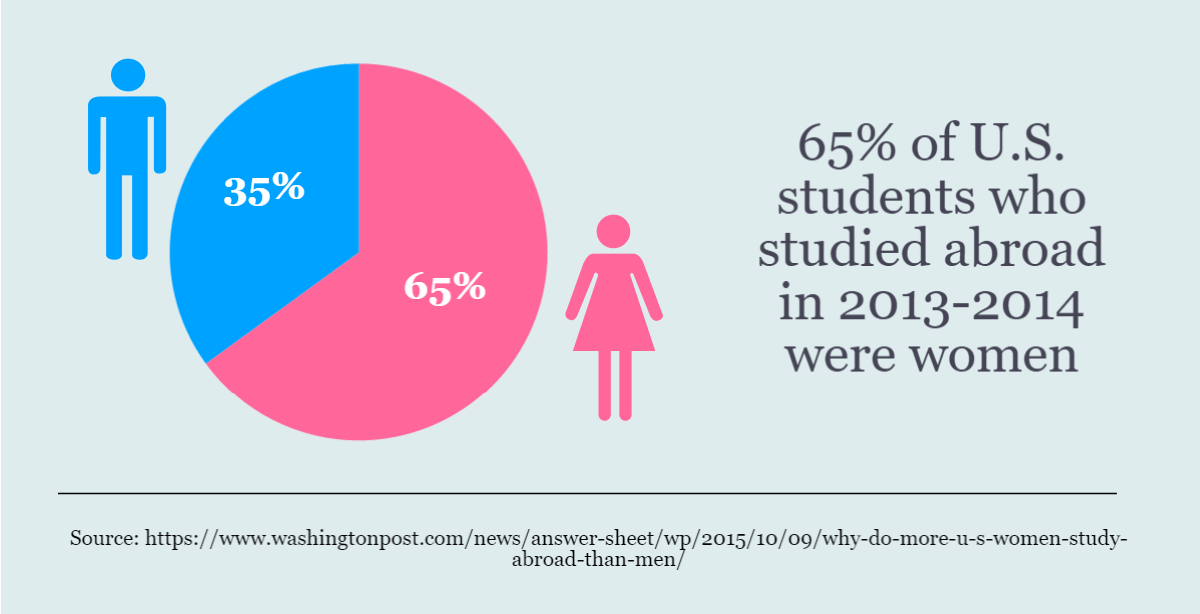
- The Institute of International Education has launched a new five-year program called “Generation Study abroad” to double the number of U.S. students studying abroad from the present number of 295,000 (10% of all American students) to 600,000 by 2019.
- Contrary to popular belief, showing cultural films in class doesn’t provide a sharp increase in students’ motivation to go abroad. In the study, during Indian movie classes, only 31% of students were motivated to study abroad.
- 90% of American college students do not study abroad at all.
Since the time of this article’s publication, Mark Shay from Abroad101 shared an interesting observation with us. The SEVIS report mentions the number of foreign students present in the country in any given year, meaning that these numbers include full degree students, as well as exchange students. When it comes to American students, however, the focus usually lies on exchange, rather than full degree, students. There is thus some discrepancy as to how the numbers are reported when it comes to international students in the U.S. and U.S. students abroad.
📚 Why is study abroad essential?
We live in an increasingly globalized world. New technologies have led to the international integration of national markets and businesses. To successfully compete in the global marketplace, multinational and small businesses need employees with cross-cultural competence and knowledge of foreign languages.
- More than 100 Chinese companies were included on the 2016 Fortune Global 500 list, which ranks the world’s largest companies based on revenue. In fact, China takes three of the top five places on the list.
- Research from the McKinsey Global Institute shows that by 2025, 45% of the world’s largest companies will probably be based in emerging markets.
- A recent survey found that almost 40% of U.S. companies missed international business opportunities due to a lack of internationally competent personnel.
- 95% of consumers live outside of the United States.
- International trade creates and supports jobs in the United States. More than one in five American jobs are tied to international trade (38 million jobs in 2013).
- According to research conducted by Professor James Foreman-Peck for the Department of Business, Innovation, and Skills (BIS), deficient language skills as well as the assumption that “everyone speaks English” are costing the UK economy about 3.5% of its GDP.
- A British Chamber of Commerce survey (2013) reveals that 62% of non-exporting British companies regarded languages as a barrier to looking for international opportunities, and 70% of exporters had no foreign-language ability in countries where they operate.
- 70% of UK businesses value foreign language skills in their employees, and 38% of businesses consider language skills particularly helpful in building relationships with clients, customers, and suppliers.
- Language barriers increase the difficulty and cost of doing business on the international market. According to a report by the University of Wales, 25% of export companies in England and Wales had lost businesses because of language and cultural deficiencies.
It is clear that employers are seeking candidates with study abroad experiences on their resumes. Students who want to work in our deeply interconnected world must study abroad.
There is no doubt that studying abroad will change your life. It offers you a chance to experience other cultures, make international friends, learn new languages, improve your job prospects, contribute to your personal development…and maybe even find the partner of your dreams!
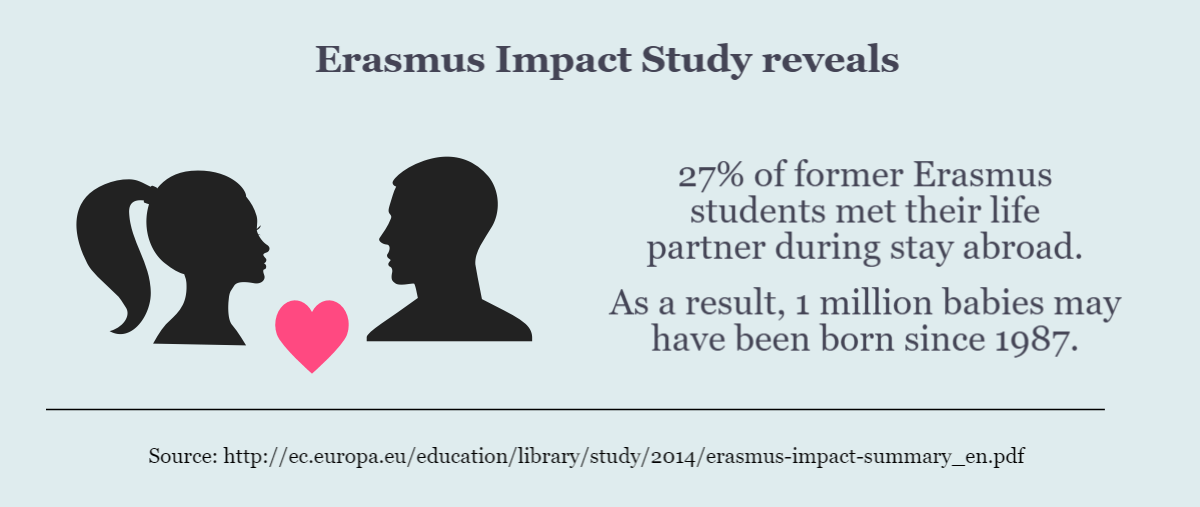
We hope that these study abroad statistics that reflect modern realities have helped you get a clearer picture of this unique, life-changing experience and understand the benefits of studying abroad. Of course, study abroad is a serious undertaking. It will challenge you on a personal level. It will have an impact on your college career. And it costs money. But it is also an investment in your future, both academically and professionally, because the study abroad experience is now more valuable than ever.
Need a guide on how to become an international student? Check out IvyPanda’s guides and infographics.
For example, you may want to know what mistakes to avoid in a foreign country (especially when you’re an international student).

![55 Study Abroad Statistics: Facts and Figures [2024 Updated]](https://ivypanda.com/blog/wp-content/uploads/2020/11/travel-necessities-704x372.jpg)





![A Shortcut to Deciding Where to Study Abroad [Infographic]](https://ivypanda.com/blog/wp-content/uploads/2016/06/portrait-smiling-woman-showing-air-ticket-passport-309x208.jpg)
Dear ivypanda.com admin, Thanks for the informative and well-written post!
Thanks for the feedback! Much appreciated.
Hi! I loved all the data, I would love to know what is the source for survey 49. Would you please help me with that?
Hello, Sara! Our experts will help you with any task!
I like how you present the data, it will be very insighful if you can update the data to be after 2020, as covid has changed a lot of things.
Thank you for your feedback, Ying. We will use it for future improvement!
Hi there. Any data on the impact of virtual study abroad experiences?
The blog is quite confusing– because at the very top it says Updated 2021, yet most of the figures stated in the article are from 2013/2014…ages ago.
P-
Thank you for your feedback. We will use it for future improvement!
Hi! thanks for the information. It’s really helpful for my study. However, may I ask for the references such as which year was the OECD report? I would love to look into the reports. Thanks again =)
Please kindly refer to the reports provided in the article, you will find all the necessary information there.
It is a great article, can you tell me the article’s publication date?
Usama, the article was originally published on 24 August 2016.
Very good article. I was searching to find out how many students who study abroad either stay abroad or return later in life to live?
Glad you liked the article, Paul!
How many people were asked? So, for example, 82% of how many students said that the exchange changed their way of looking at the word?
Richard,
All the information was taken here: https://www.iesabroad.org/study-abroad/benefits/alumni-survey-results
I love how comprehensive this article is. I particularly enjoyed the last stat about the percentage of Erasmus students finding life partners on their exchange! Definitely not a factor that is often considered, but an important one none the less.
I write for a website geared towards students studying abroad and we recently published the results of a survey that includes the responses of over 20,000 international students. It includes up to date information on what is inspiring students to study abroad and the destinations they are choosing. I would love to get in touch to share either our stats or infographics!
Glad you liked the article, Dan!
You are mistaken. I suggest it to discuss.
Hi there! Please, feel free to write your thoughts 🙂
Hey Ruth,
Great article. I work in a study abroad office and do communication and recruitment. I am wondering if you have any up to date or current stats? Do you know where I could get that info? Would searching through the references in this article be a good place to start?
Thanks!
Kate
Hello Kate!
Glad you liked my article!
Regarding your question. You can definitely search through references in the article, maybe you will find something about 2016-2017 years. I also recommend that you visit nafsa.org and this resource, but it depends on what statistics in international education you are interested in. Here you can find publications on statistics. Hope this will help!
Great article, thanks for the information.
Glad you liked it! Thank you for the feedback.
Hi, helpful information about abroad studies. Thanks for sharing.
Hi!
That’s great to know you liked it. Thanks for your feedback 🙂
Study abroad is a great way to make a bright future.
Completely agree with you, Aus Guru! Thanks for the feedback!
Excellent article, Ruth. I will certainly use it to talk to parents. It is just what I was searching for. It is great to see all this information in one place. Well done.
Anne Hallihan
Thanks for such kind words, Anne! I’m glad you found it helpful. Good luck with your parents!